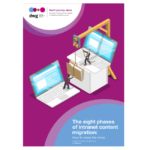What role does the digital workplace play in customer experience?
 In the past couple of years digital workplace teams, HR professionals and internal communicators have become more interested in the concept of “employee experience”, a high-level term that emphasizes the importance of all the touchpoints the workforce has with their employer. Obviously, the digital workplace can have a significant impact on employee experience.
In the past couple of years digital workplace teams, HR professionals and internal communicators have become more interested in the concept of “employee experience”, a high-level term that emphasizes the importance of all the touchpoints the workforce has with their employer. Obviously, the digital workplace can have a significant impact on employee experience.
The term can be very useful, especially in organizations where management are comfortable with the concept of “customer experience”. With “employee experience” an obvious internal-looking counterpoint, it means that senior management can instinctively understand its importance. An interesting postscript to this is the notion that, actually, employee experience plays an essential part in customer experience as well, and the two concepts are intertwined – a digital Yin and Yang.
This latter idea is very useful for digital workplace teams, because it provides a compelling business case for instances where demonstrating the tangible benefits of employee experience is not straightforward. Traditionally, investment in the internal digital workplace has lagged behind the spending commitments companies make in digital to drive a better customer experience, but this is hopefully starting to change. In his digital workplace predictions for 2019, DWG’s CEO and Founder Paul Miller predicted that “(External) customer success is increasingly seen as grounded in (internal) digital workplace success”.
Is there really a link between employee experience and customer experience?
Most digital workplace professionals see a clear link between the digital workplace, employee experience and customer experience. A strong digital workplace supports a strong employee experience, and that in turn helps to drive better customer service and higher quality experiences for customers, particularly across digital touchpoints.
However, not everyone necessarily buys into this view and the importance of the link can be exaggerated. For example, there are definitely examples of good customer experiences that are not dependent on a strong employee experience. It may be the case that the rapid delivery of goods you ordered on the intranet was dependent on less than ideal working conditions in the warehouse, or perhaps the great service you received from a professional services firm relied on some people working extremely long and stressful hours.
What does the research say?
There is a real shortage of good quality research that shows the link between the internal (digital workplace, employee experience) and the external (customer experience) – but there has been some. Perhaps the most prominent is that carried out by Kristian Dery and Ina Sebastian from MIT Sloan’s Center for Information Systems Research (CISR), who compared companies with high- and low-rated levels of employee experience and showed that the former had better levels of:
- innovation (reflected in higher proportions of revenue from new products and services)
- customer satisfaction (reflected in Net Promoter Scores)
- profitability (reflected in levels of profits made).
More recently, employer review site Glassdoor produced research that demonstrated a link between positive employee ratings and customer satisfaction. Studying the ratings of almost 300 large employees, the report concludes that every increase of one point out of five in an employee rating leads to a 1.3 point increase in customer satisfaction out of 100. The impact of this is more than double in sectors such as retail and leisure, where customers have a high degree of direct contact with employees.
Unfortunately, the levels of research are currently not sufficient to establish a consensus that investment in employee experience and the digital workplace really does support better customer service. Many digital workplace teams still struggle to make the business case for investment and, in many organizations, a short-term view still tends to prioritize budget on external-facing channels and apps over internal ones.
The connection between the digital workplace and customer experience
At the same time there are some leading-edge organizations that place more emphasis on employee experience and have been vocal about its link to customer experience. Companies such as Southwest Airlines (a DWG member) have long believed in this link and have developed strong levels of loyalty from both employees and customers as a result.
In our view, there are plenty of obvious examples of the digital workplace helping to drive a better customer experience, including by:
- Supporting employees with specific information about customers, usually through a CRM system, to enable better service.
- Allowing for better customer support by providing employees with up-to-date product and service information, for example through knowledge management solutions to contact centre staff, enabling faster resolution of issues.
- Providing collaboration solutions to allow multidisciplinary or distributed teams to work together to provide a more coordinated and efficient service to customers, as well as drive collaboration on new products and services.
- Supporting process automation for more efficient service delivery.
- Allowing the capture of customer data and insights that can again help to refine and improve the offering.
- Driving a more agile workforce who can respond more quickly to the external environment.
- Driving the capture of ideas and feedback from customer-facing staff that can lead to innovation and improvements in customer service.
- Supporting a happier, more energized and motivated workforce, which can have a real-world impact on customer experiences, particularly in “high-touch” sectors, such as retail.
Navigating the connection
Investigating and navigating the connection between customer experience and the digital workplace is time well spent for digital workplace teams, through supporting business cases for investment and turning up use cases for digital workplace tools that can have a real impact. It’s easy to exaggerate the dependencies between employee experience and customer experience, but working out where they are in your organization can help you to deliver a better digital workplace.
Take the next step…
Categorised in: Uncategorized

